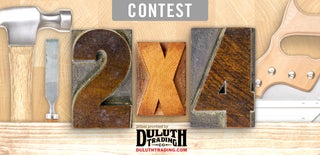Introduction: Knife Rack
This is how I made my knife rack with materials I had laying around the shop. The wood used in this project was a scrap 2x4 but feel free to use any material you want.
total cost: $0
time: 30 mins
materials used: wood, wood glue, super glue (optional), metal rod, screws
tools used: table saw, miter saw, metal cutting band saw, drill press
Step 1: Rip Rip Rip Your Boards Gently Down the Grain
Rip your board so that you get a strip that's a 1/4 of an inch thick. How wide you want your knife rack really doesn't matter; go with 1,1/4 inches for a slimmer look, all the way to two 2 inches or more for a beefier look. The one in the picture is just a hair below 1,1/2 inches. If you don't have a table saw just pick up a board that's the right dimensions.
Step 2: Cut to Size
You'll need two 18 inch strips and three 1 inch strips. I chose 18 inches so that I could screw them directly into the studs of my wall. Make sure you find where you want to put the rack before you make it so you don't end up with one too long or short. The 1 inch strips are spacers for where the knifes go; I chose to use three but if you have a shorter length two would work fine as well.
Step 3: Glue Up
Take your short pieces and put a thin layer of wood glue on them. I like to put a dab of superglue so that the small pieces don't move around as much. You'll need to put two of the short pieces flush with the ends of the longer ones, along with one short piece in the center. Once the superglue has dried put another layer of wood glue on the tops of the small pieces and add the longer piece on top.
Step 4: Clamp and Wait
You don't need to clamp it that long because the super glue will hold it together. The temporary superglue joint wont be as strong but will allow you to continue working on your piece.
Step 5: Holes
The first set of holes will be the pilot holes for the screws and should be centered over the small spacers. The next set of holes will be the countersink. Measure the width of the heads of the screws you plan on using and drill a hole slightly larger; the width of this hole will be the diameter of the rod you need for the plugs. The larger hole should be deep enough to fit the head of the screw and the plug that will go on top. Mine were a hair proud of an eighth of an inch deep.
Step 6: Cut the Plugs
You can use any material you want for the plugs; I used a scrap piece of mild steel rod. Make sure the diameter of the rod is the same as the hole you drilled. Before cutting each piece I placed a small chamfer on the rod so that they'll be easier to put in.
Step 7: Sand and Finish
I used a disk sander to get square edges.
Step 8: Mount and Use
This is one I made with some hard wood.

Participated in the
2x4 Contest









